engine coolant FORD EDGE 2023 Owners Manual
[x] Cancel search | Manufacturer: FORD, Model Year: 2023, Model line: EDGE, Model: FORD EDGE 2023Pages: 504, PDF Size: 14.96 MB
Page 7 of 504
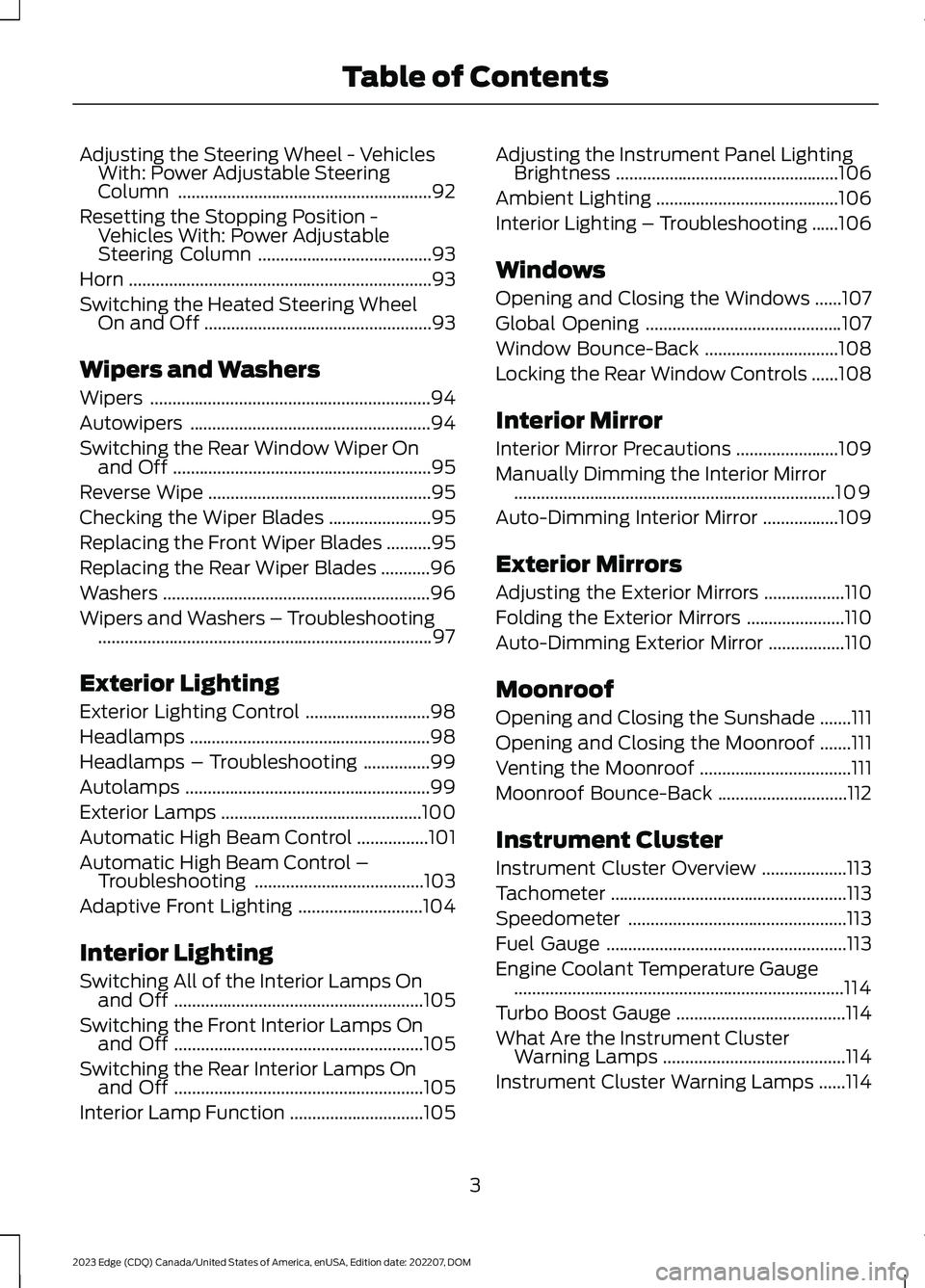
Adjusting the Steering Wheel - VehiclesWith: Power Adjustable SteeringColumn.........................................................92
Resetting the Stopping Position -Vehicles With: Power AdjustableSteering Column.......................................93
Horn....................................................................93
Switching the Heated Steering WheelOn and Off...................................................93
Wipers and Washers
Wipers...............................................................94
Autowipers......................................................94
Switching the Rear Window Wiper Onand Off..........................................................95
Reverse Wipe..................................................95
Checking the Wiper Blades.......................95
Replacing the Front Wiper Blades..........95
Replacing the Rear Wiper Blades...........96
Washers............................................................96
Wipers and Washers – Troubleshooting...........................................................................97
Exterior Lighting
Exterior Lighting Control............................98
Headlamps......................................................98
Headlamps – Troubleshooting...............99
Autolamps.......................................................99
Exterior Lamps.............................................100
Automatic High Beam Control................101
Automatic High Beam Control –Troubleshooting......................................103
Adaptive Front Lighting............................104
Interior Lighting
Switching All of the Interior Lamps Onand Off........................................................105
Switching the Front Interior Lamps Onand Off........................................................105
Switching the Rear Interior Lamps Onand Off........................................................105
Interior Lamp Function..............................105
Adjusting the Instrument Panel LightingBrightness..................................................106
Ambient Lighting.........................................106
Interior Lighting – Troubleshooting......106
Windows
Opening and Closing the Windows......107
Global Opening............................................107
Window Bounce-Back..............................108
Locking the Rear Window Controls......108
Interior Mirror
Interior Mirror Precautions.......................109
Manually Dimming the Interior Mirror........................................................................109
Auto-Dimming Interior Mirror.................109
Exterior Mirrors
Adjusting the Exterior Mirrors..................110
Folding the Exterior Mirrors......................110
Auto-Dimming Exterior Mirror.................110
Moonroof
Opening and Closing the Sunshade.......111
Opening and Closing the Moonroof.......111
Venting the Moonroof..................................111
Moonroof Bounce-Back.............................112
Instrument Cluster
Instrument Cluster Overview...................113
Tachometer.....................................................113
Speedometer.................................................113
Fuel Gauge......................................................113
Engine Coolant Temperature Gauge..........................................................................114
Turbo Boost Gauge......................................114
What Are the Instrument ClusterWarning Lamps.........................................114
Instrument Cluster Warning Lamps......114
3
2023 Edge (CDQ) Canada/United States of America, enUSA, Edition date: 202207, DOMTable of Contents
Page 13 of 504
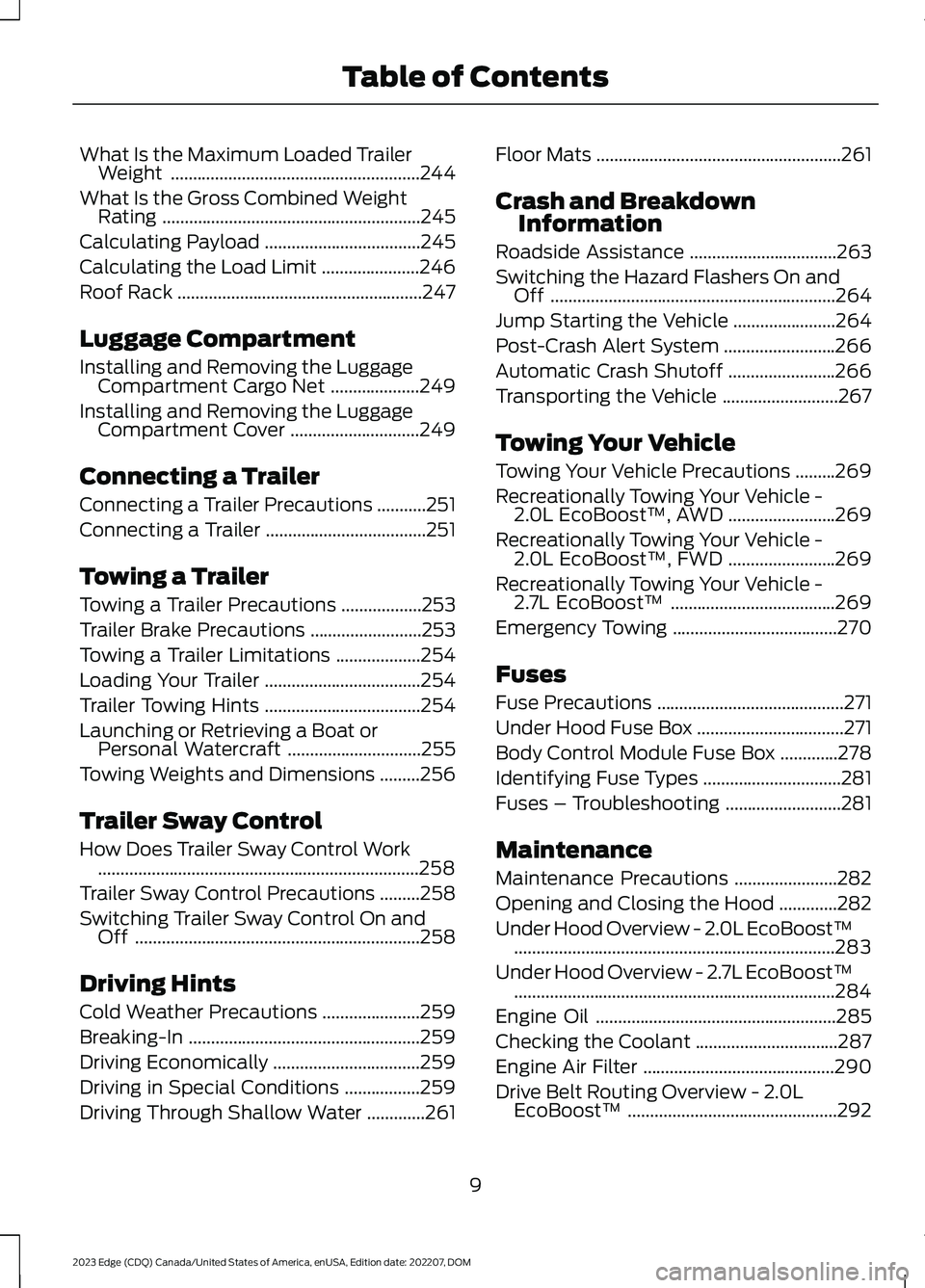
What Is the Maximum Loaded TrailerWeight........................................................244
What Is the Gross Combined WeightRating..........................................................245
Calculating Payload...................................245
Calculating the Load Limit......................246
Roof Rack.......................................................247
Luggage Compartment
Installing and Removing the LuggageCompartment Cargo Net....................249
Installing and Removing the LuggageCompartment Cover.............................249
Connecting a Trailer
Connecting a Trailer Precautions...........251
Connecting a Trailer....................................251
Towing a Trailer
Towing a Trailer Precautions..................253
Trailer Brake Precautions.........................253
Towing a Trailer Limitations...................254
Loading Your Trailer...................................254
Trailer Towing Hints...................................254
Launching or Retrieving a Boat orPersonal Watercraft..............................255
Towing Weights and Dimensions.........256
Trailer Sway Control
How Does Trailer Sway Control Work........................................................................258
Trailer Sway Control Precautions.........258
Switching Trailer Sway Control On andOff................................................................258
Driving Hints
Cold Weather Precautions......................259
Breaking-In....................................................259
Driving Economically.................................259
Driving in Special Conditions.................259
Driving Through Shallow Water.............261
Floor Mats.......................................................261
Crash and BreakdownInformation
Roadside Assistance.................................263
Switching the Hazard Flashers On andOff................................................................264
Jump Starting the Vehicle.......................264
Post-Crash Alert System.........................266
Automatic Crash Shutoff........................266
Transporting the Vehicle..........................267
Towing Your Vehicle
Towing Your Vehicle Precautions.........269
Recreationally Towing Your Vehicle -2.0L EcoBoost™, AWD........................269
Recreationally Towing Your Vehicle -2.0L EcoBoost™, FWD........................269
Recreationally Towing Your Vehicle -2.7L EcoBoost™.....................................269
Emergency Towing.....................................270
Fuses
Fuse Precautions..........................................271
Under Hood Fuse Box.................................271
Body Control Module Fuse Box.............278
Identifying Fuse Types...............................281
Fuses – Troubleshooting..........................281
Maintenance
Maintenance Precautions.......................282
Opening and Closing the Hood.............282
Under Hood Overview - 2.0L EcoBoost™........................................................................283
Under Hood Overview - 2.7L EcoBoost™........................................................................284
Engine Oil......................................................285
Checking the Coolant................................287
Engine Air Filter...........................................290
Drive Belt Routing Overview - 2.0LEcoBoost™...............................................292
9
2023 Edge (CDQ) Canada/United States of America, enUSA, Edition date: 202207, DOMTable of Contents
Page 21 of 504
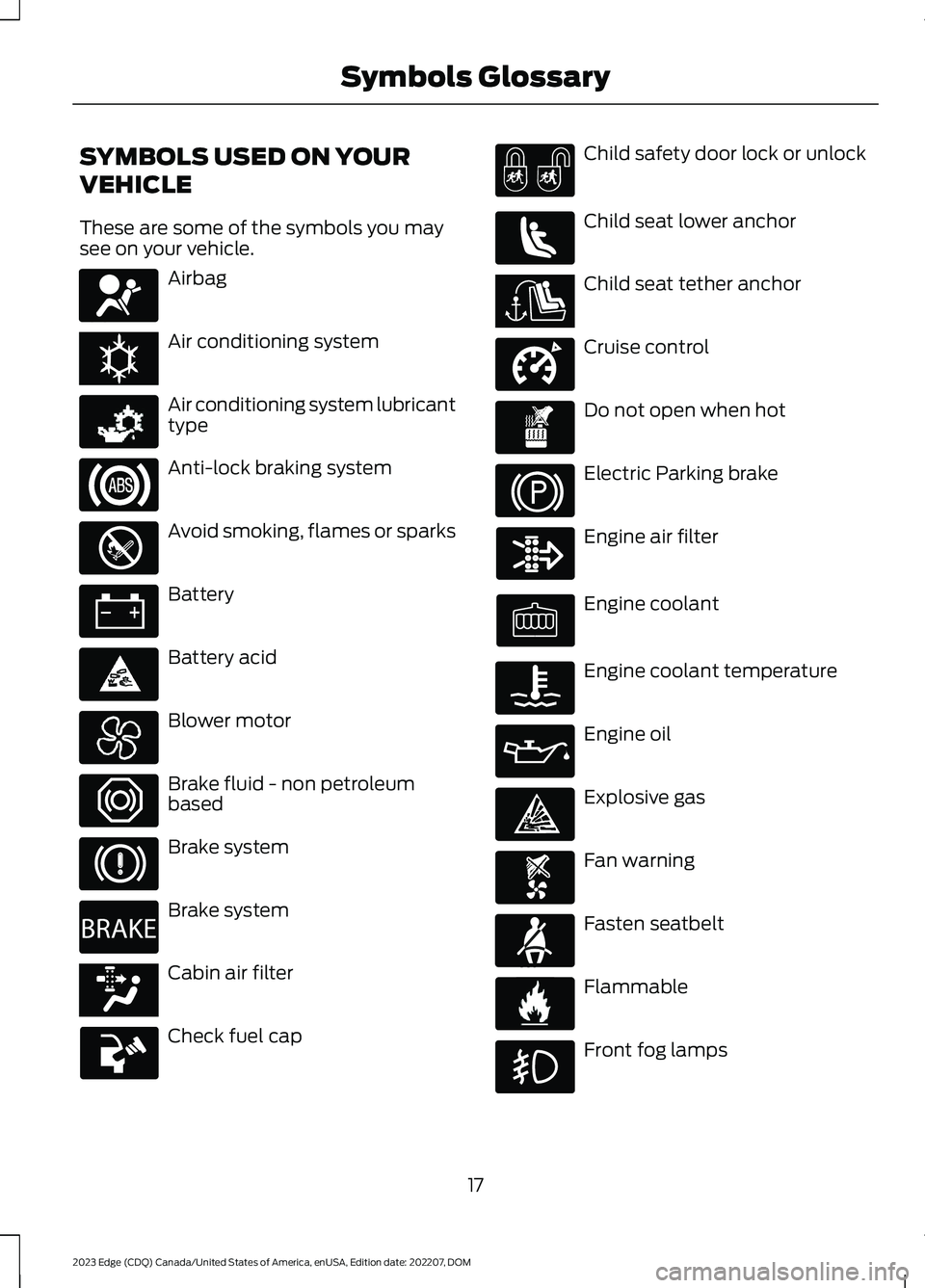
SYMBOLS USED ON YOUR
VEHICLE
These are some of the symbols you maysee on your vehicle.
Airbag
Air conditioning system
Air conditioning system lubricanttype
Anti-lock braking system
Avoid smoking, flames or sparks
Battery
Battery acid
Blower motor
Brake fluid - non petroleumbased
Brake system
Brake system
Cabin air filter
Check fuel cap
Child safety door lock or unlock
Child seat lower anchor
Child seat tether anchor
Cruise control
Do not open when hot
Electric Parking brake
Engine air filter
Engine coolant
Engine coolant temperature
Engine oil
Explosive gas
Fan warning
Fasten seatbelt
Flammable
Front fog lamps
17
2023 Edge (CDQ) Canada/United States of America, enUSA, Edition date: 202207, DOMSymbols GlossaryE67017 E162384 E231157 E67020 E139220 E67021 E139227 E139209 E67024 E270480 E139223 E139211 E141128 E332905 E139219 E139212 E103308 E67022 E139221 E139228 E71880 E231160
Page 118 of 504
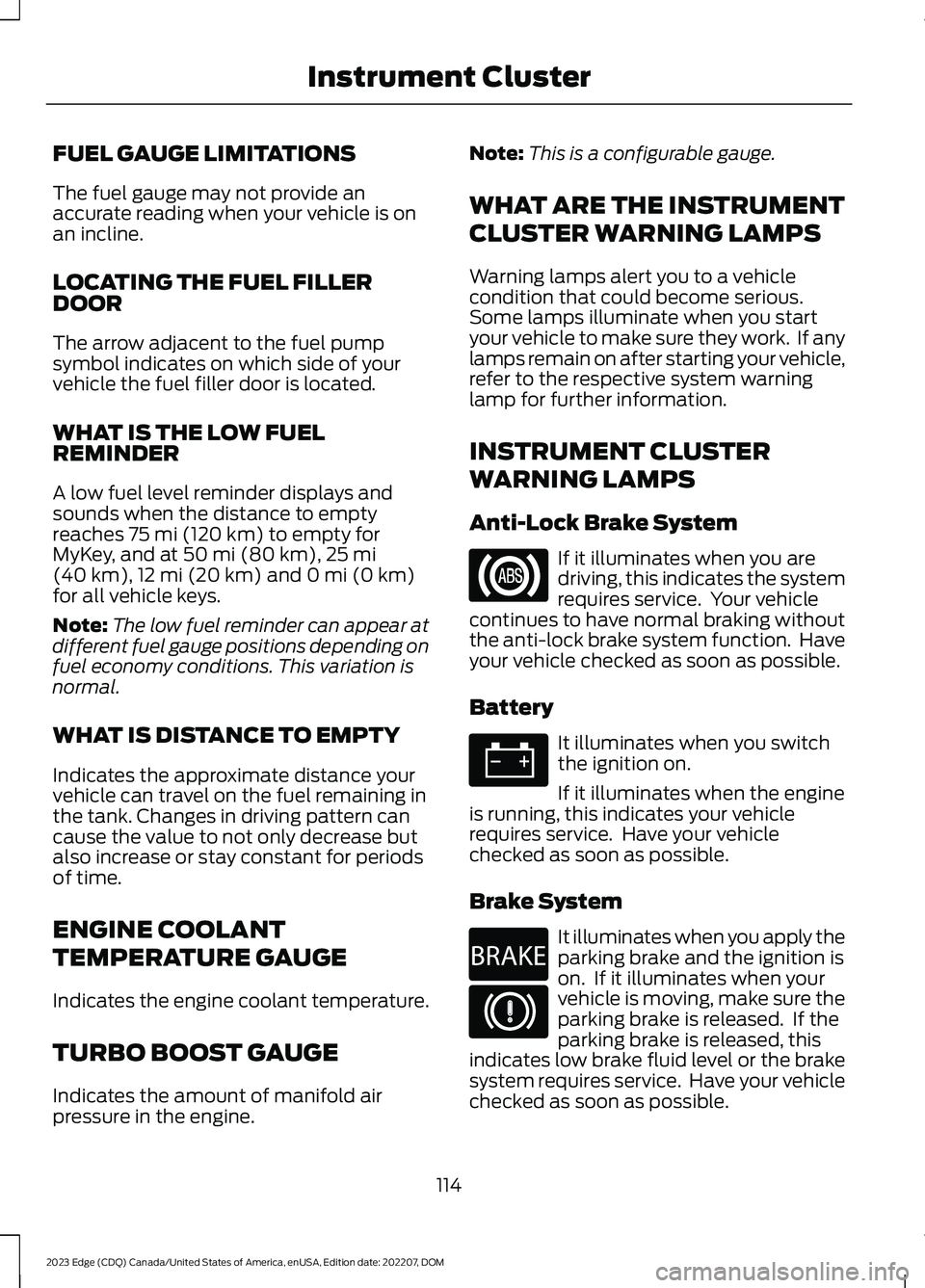
FUEL GAUGE LIMITATIONS
The fuel gauge may not provide anaccurate reading when your vehicle is onan incline.
LOCATING THE FUEL FILLERDOOR
The arrow adjacent to the fuel pumpsymbol indicates on which side of yourvehicle the fuel filler door is located.
WHAT IS THE LOW FUELREMINDER
A low fuel level reminder displays andsounds when the distance to emptyreaches 75 mi (120 km) to empty forMyKey, and at 50 mi (80 km),25 mi(40 km),12 mi (20 km) and 0 mi (0 km)for all vehicle keys.
Note:The low fuel reminder can appear atdifferent fuel gauge positions depending onfuel economy conditions. This variation isnormal.
WHAT IS DISTANCE TO EMPTY
Indicates the approximate distance yourvehicle can travel on the fuel remaining inthe tank. Changes in driving pattern cancause the value to not only decrease butalso increase or stay constant for periodsof time.
ENGINE COOLANT
TEMPERATURE GAUGE
Indicates the engine coolant temperature.
TURBO BOOST GAUGE
Indicates the amount of manifold airpressure in the engine.
Note:This is a configurable gauge.
WHAT ARE THE INSTRUMENT
CLUSTER WARNING LAMPS
Warning lamps alert you to a vehiclecondition that could become serious.Some lamps illuminate when you startyour vehicle to make sure they work. If anylamps remain on after starting your vehicle,refer to the respective system warninglamp for further information.
INSTRUMENT CLUSTER
WARNING LAMPS
Anti-Lock Brake System
If it illuminates when you aredriving, this indicates the systemrequires service. Your vehiclecontinues to have normal braking withoutthe anti-lock brake system function. Haveyour vehicle checked as soon as possible.
Battery
It illuminates when you switchthe ignition on.
If it illuminates when the engineis running, this indicates your vehiclerequires service. Have your vehiclechecked as soon as possible.
Brake System
It illuminates when you apply theparking brake and the ignition ison. If it illuminates when yourvehicle is moving, make sure theparking brake is released. If theparking brake is released, thisindicates low brake fluid level or the brakesystem requires service. Have your vehiclechecked as soon as possible.
114
2023 Edge (CDQ) Canada/United States of America, enUSA, Edition date: 202207, DOMInstrument ClusterE67020 E67021 E270480 E67024
Page 119 of 504
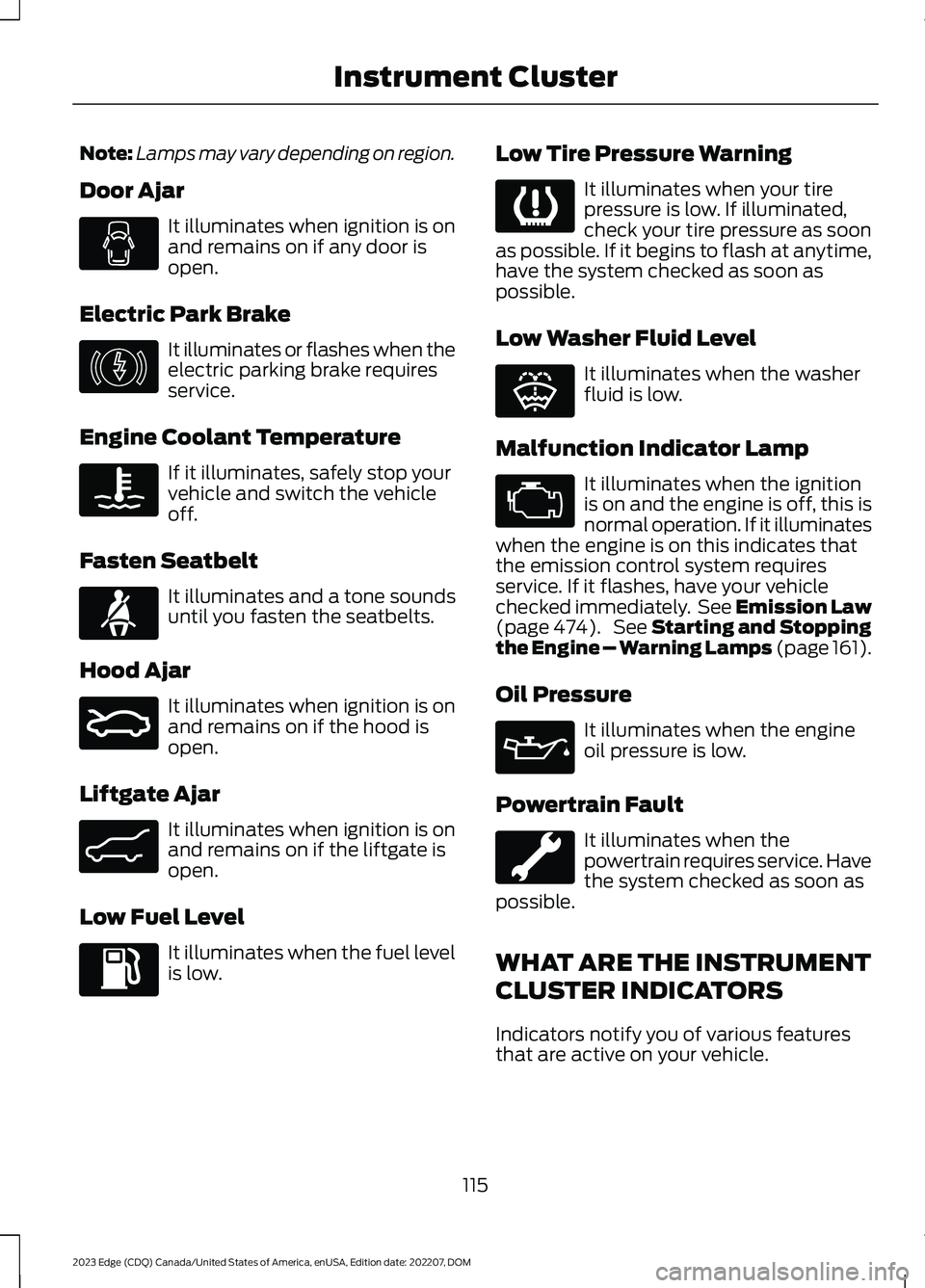
Note:Lamps may vary depending on region.
Door Ajar
It illuminates when ignition is onand remains on if any door isopen.
Electric Park Brake
It illuminates or flashes when theelectric parking brake requiresservice.
Engine Coolant Temperature
If it illuminates, safely stop yourvehicle and switch the vehicleoff.
Fasten Seatbelt
It illuminates and a tone soundsuntil you fasten the seatbelts.
Hood Ajar
It illuminates when ignition is onand remains on if the hood isopen.
Liftgate Ajar
It illuminates when ignition is onand remains on if the liftgate isopen.
Low Fuel Level
It illuminates when the fuel levelis low.
Low Tire Pressure Warning
It illuminates when your tirepressure is low. If illuminated,check your tire pressure as soonas possible. If it begins to flash at anytime,have the system checked as soon aspossible.
Low Washer Fluid Level
It illuminates when the washerfluid is low.
Malfunction Indicator Lamp
It illuminates when the ignitionis on and the engine is off, this isnormal operation. If it illuminateswhen the engine is on this indicates thatthe emission control system requiresservice. If it flashes, have your vehiclechecked immediately. See Emission Law(page 474). See Starting and Stoppingthe Engine – Warning Lamps (page 161).
Oil Pressure
It illuminates when the engineoil pressure is low.
Powertrain Fault
It illuminates when thepowertrain requires service. Havethe system checked as soon aspossible.
WHAT ARE THE INSTRUMENT
CLUSTER INDICATORS
Indicators notify you of various featuresthat are active on your vehicle.
115
2023 Edge (CDQ) Canada/United States of America, enUSA, Edition date: 202207, DOMInstrument Cluster E146190 E103308 E71880 E159324 E162453 E139232 E132353 E67028 E67022
Page 163 of 504
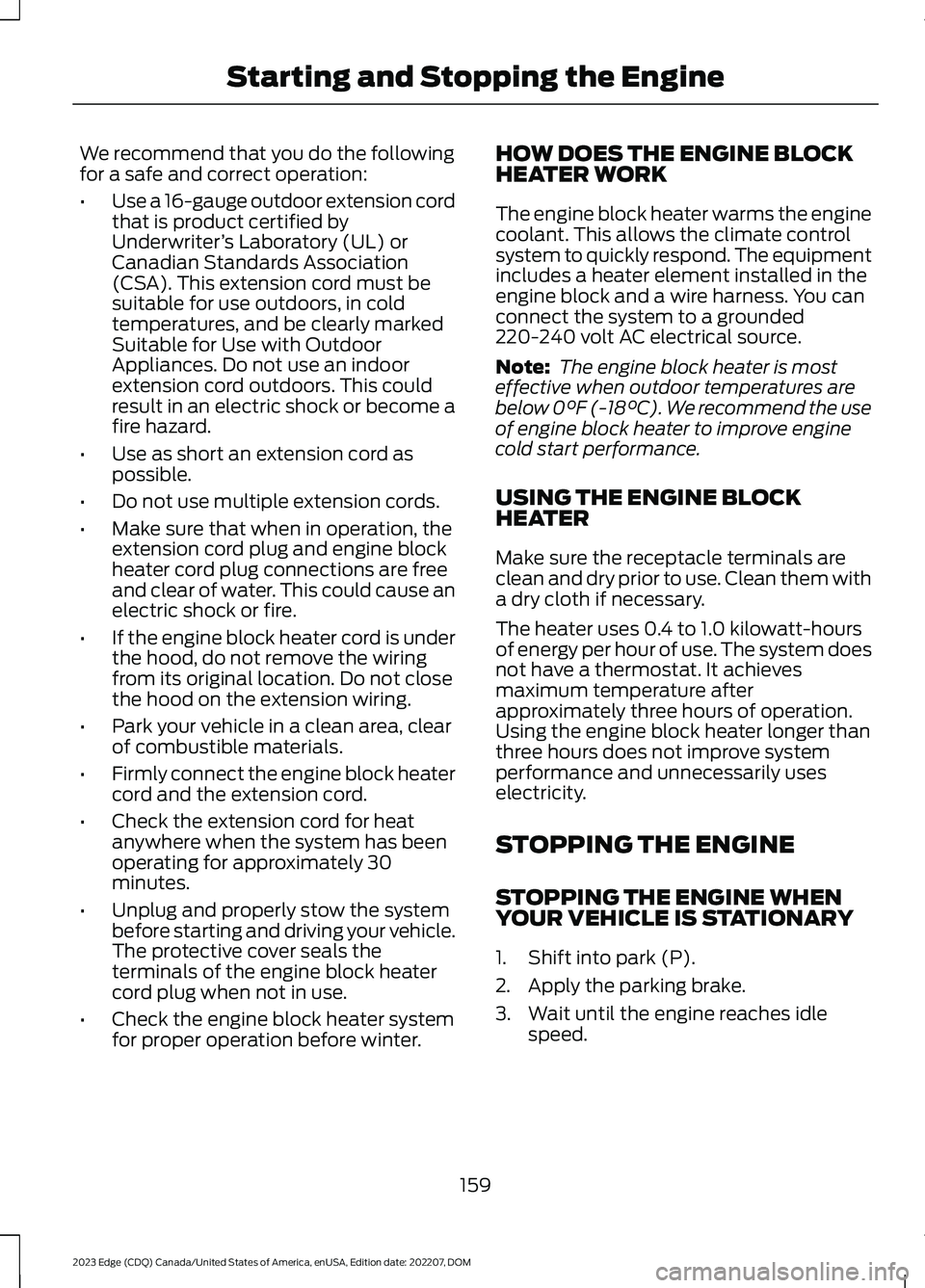
We recommend that you do the followingfor a safe and correct operation:
•Use a 16-gauge outdoor extension cordthat is product certified byUnderwriter’s Laboratory (UL) orCanadian Standards Association(CSA). This extension cord must besuitable for use outdoors, in coldtemperatures, and be clearly markedSuitable for Use with OutdoorAppliances. Do not use an indoorextension cord outdoors. This couldresult in an electric shock or become afire hazard.
•Use as short an extension cord aspossible.
•Do not use multiple extension cords.
•Make sure that when in operation, theextension cord plug and engine blockheater cord plug connections are freeand clear of water. This could cause anelectric shock or fire.
•If the engine block heater cord is underthe hood, do not remove the wiringfrom its original location. Do not closethe hood on the extension wiring.
•Park your vehicle in a clean area, clearof combustible materials.
•Firmly connect the engine block heatercord and the extension cord.
•Check the extension cord for heatanywhere when the system has beenoperating for approximately 30minutes.
•Unplug and properly stow the systembefore starting and driving your vehicle.The protective cover seals theterminals of the engine block heatercord plug when not in use.
•Check the engine block heater systemfor proper operation before winter.
HOW DOES THE ENGINE BLOCKHEATER WORK
The engine block heater warms the enginecoolant. This allows the climate controlsystem to quickly respond. The equipmentincludes a heater element installed in theengine block and a wire harness. You canconnect the system to a grounded220-240 volt AC electrical source.
Note: The engine block heater is mosteffective when outdoor temperatures arebelow 0°F (-18°C). We recommend the useof engine block heater to improve enginecold start performance.
USING THE ENGINE BLOCKHEATER
Make sure the receptacle terminals areclean and dry prior to use. Clean them witha dry cloth if necessary.
The heater uses 0.4 to 1.0 kilowatt-hoursof energy per hour of use. The system doesnot have a thermostat. It achievesmaximum temperature afterapproximately three hours of operation.Using the engine block heater longer thanthree hours does not improve systemperformance and unnecessarily useselectricity.
STOPPING THE ENGINE
STOPPING THE ENGINE WHENYOUR VEHICLE IS STATIONARY
1.Shift into park (P).
2.Apply the parking brake.
3.Wait until the engine reaches idlespeed.
159
2023 Edge (CDQ) Canada/United States of America, enUSA, Edition date: 202207, DOMStarting and Stopping the Engine
Page 287 of 504
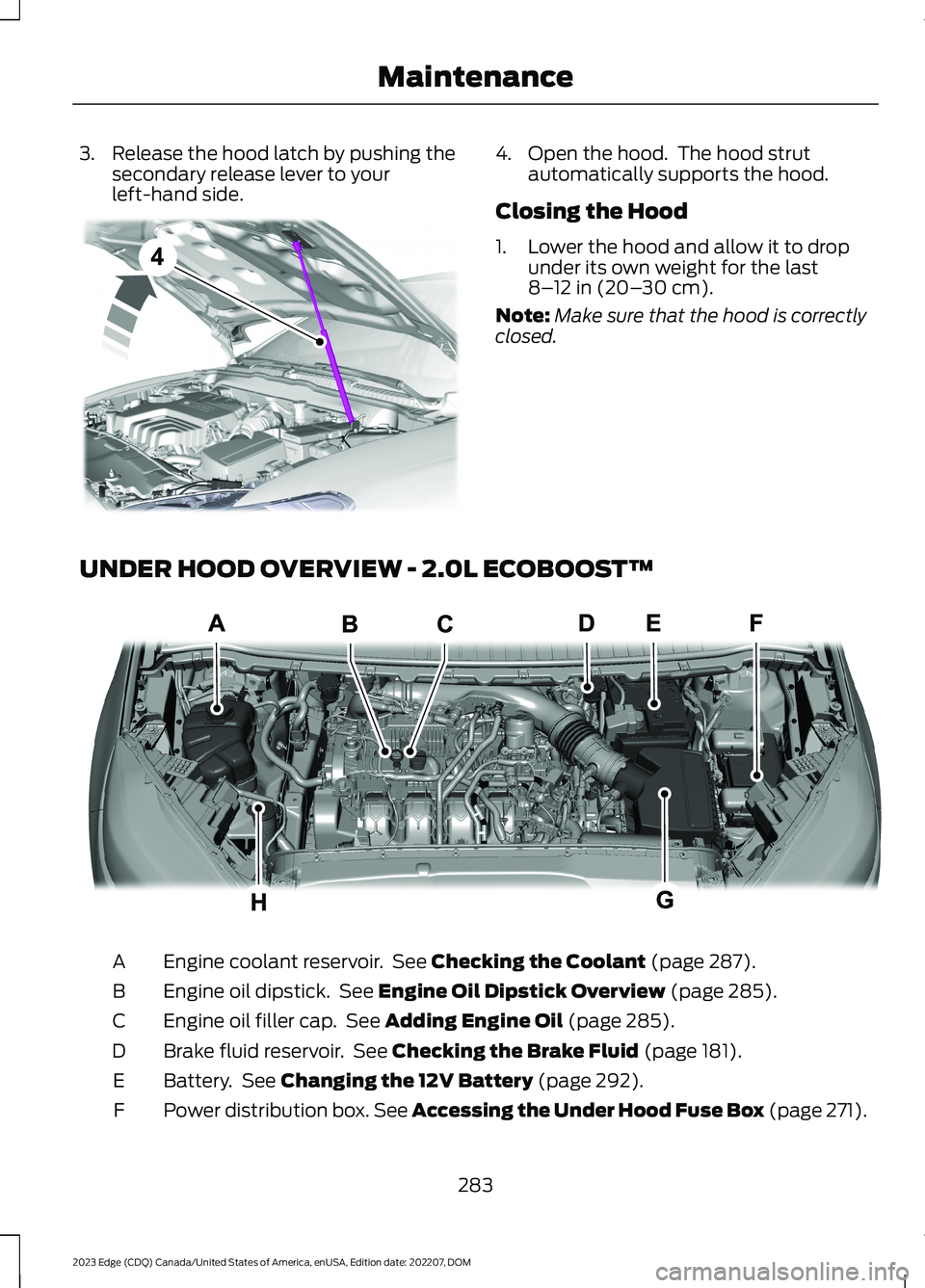
3.Release the hood latch by pushing thesecondary release lever to yourleft-hand side.
4.Open the hood. The hood strutautomatically supports the hood.
Closing the Hood
1.Lower the hood and allow it to dropunder its own weight for the last8–12 in (20–30 cm).
Note:Make sure that the hood is correctlyclosed.
UNDER HOOD OVERVIEW - 2.0L ECOBOOST™
Engine coolant reservoir. See Checking the Coolant (page 287).A
Engine oil dipstick. See Engine Oil Dipstick Overview (page 285).B
Engine oil filler cap. See Adding Engine Oil (page 285).C
Brake fluid reservoir. See Checking the Brake Fluid (page 181).D
Battery. See Changing the 12V Battery (page 292).E
Power distribution box. See Accessing the Under Hood Fuse Box (page 271).F
283
2023 Edge (CDQ) Canada/United States of America, enUSA, Edition date: 202207, DOMMaintenance4 E191432 E294775
Page 288 of 504
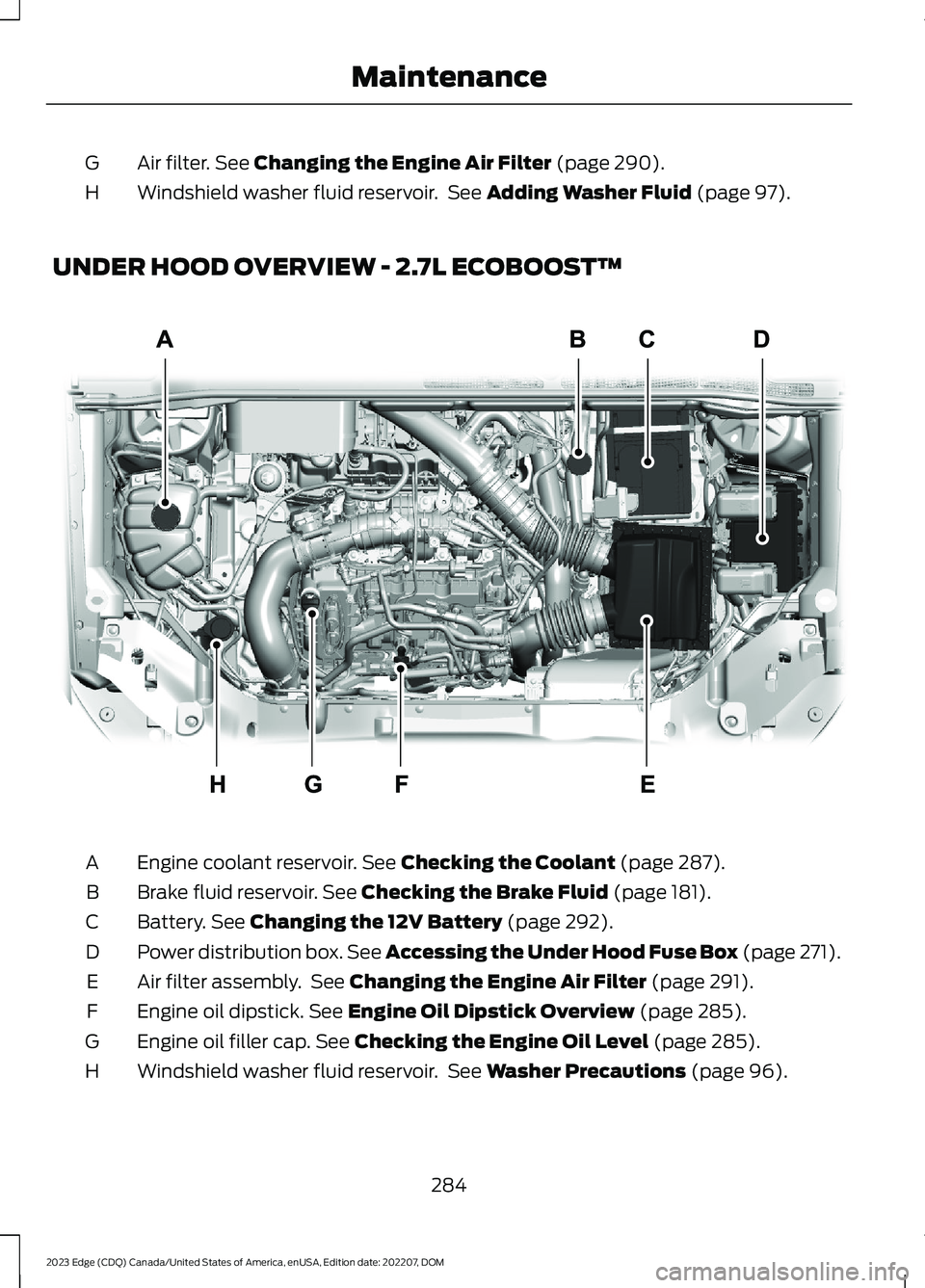
Air filter. See Changing the Engine Air Filter (page 290).G
Windshield washer fluid reservoir. See Adding Washer Fluid (page 97).H
UNDER HOOD OVERVIEW - 2.7L ECOBOOST™
Engine coolant reservoir. See Checking the Coolant (page 287).A
Brake fluid reservoir. See Checking the Brake Fluid (page 181).B
Battery. See Changing the 12V Battery (page 292).C
Power distribution box. See Accessing the Under Hood Fuse Box (page 271).D
Air filter assembly. See Changing the Engine Air Filter (page 291).E
Engine oil dipstick. See Engine Oil Dipstick Overview (page 285).F
Engine oil filler cap. See Checking the Engine Oil Level (page 285).G
Windshield washer fluid reservoir. See Washer Precautions (page 96).H
284
2023 Edge (CDQ) Canada/United States of America, enUSA, Edition date: 202207, DOMMaintenanceE341585
Page 291 of 504
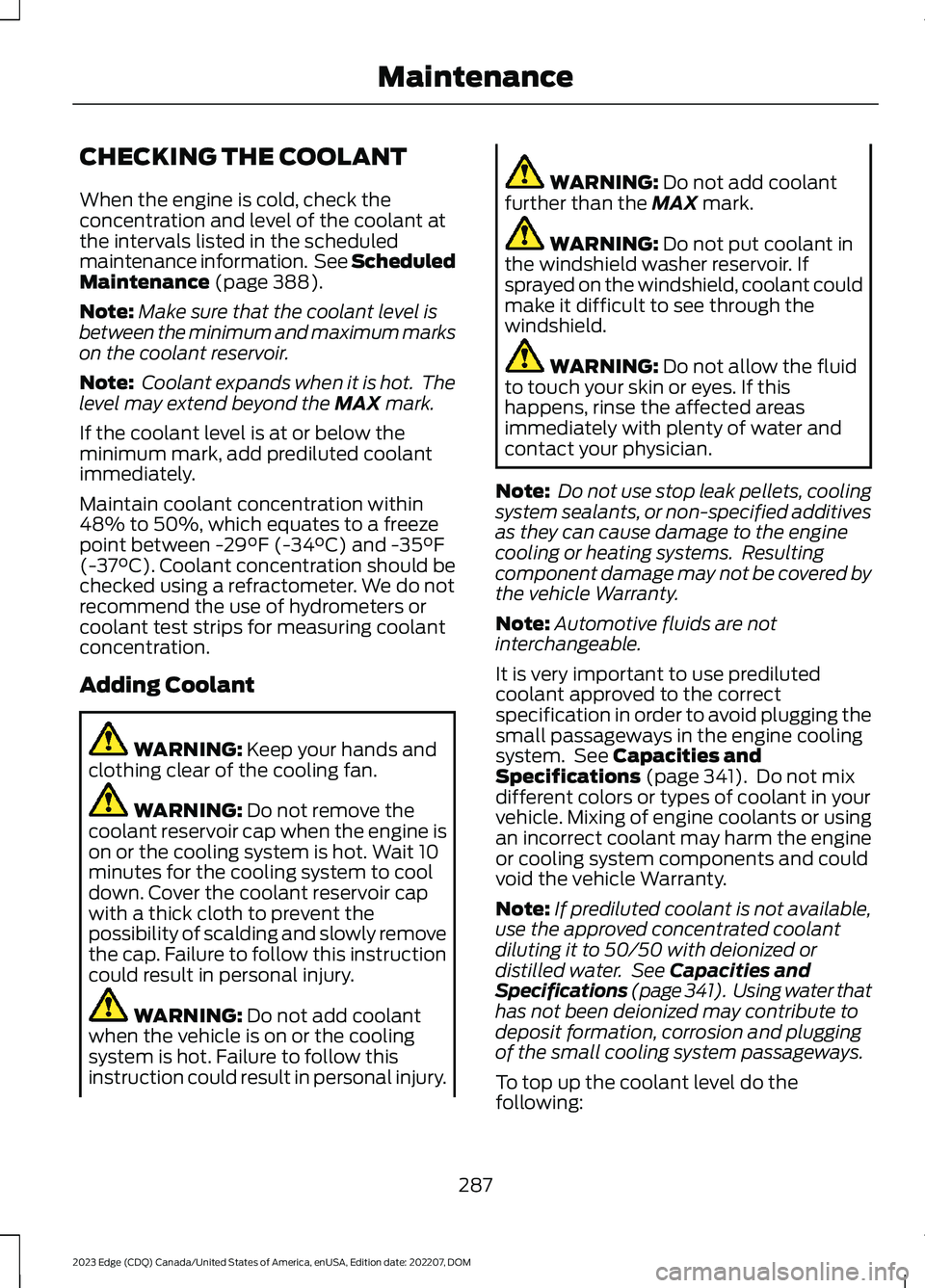
CHECKING THE COOLANT
When the engine is cold, check theconcentration and level of the coolant atthe intervals listed in the scheduledmaintenance information. See ScheduledMaintenance (page 388).
Note:Make sure that the coolant level isbetween the minimum and maximum markson the coolant reservoir.
Note: Coolant expands when it is hot. Thelevel may extend beyond the MAX mark.
If the coolant level is at or below theminimum mark, add prediluted coolantimmediately.
Maintain coolant concentration within48% to 50%, which equates to a freezepoint between -29°F (-34°C) and -35°F(-37°C). Coolant concentration should bechecked using a refractometer. We do notrecommend the use of hydrometers orcoolant test strips for measuring coolantconcentration.
Adding Coolant
WARNING: Keep your hands andclothing clear of the cooling fan.
WARNING: Do not remove thecoolant reservoir cap when the engine ison or the cooling system is hot. Wait 10minutes for the cooling system to cooldown. Cover the coolant reservoir capwith a thick cloth to prevent thepossibility of scalding and slowly removethe cap. Failure to follow this instructioncould result in personal injury.
WARNING: Do not add coolantwhen the vehicle is on or the coolingsystem is hot. Failure to follow thisinstruction could result in personal injury.
WARNING: Do not add coolantfurther than the MAX mark.
WARNING: Do not put coolant inthe windshield washer reservoir. Ifsprayed on the windshield, coolant couldmake it difficult to see through thewindshield.
WARNING: Do not allow the fluidto touch your skin or eyes. If thishappens, rinse the affected areasimmediately with plenty of water andcontact your physician.
Note: Do not use stop leak pellets, coolingsystem sealants, or non-specified additivesas they can cause damage to the enginecooling or heating systems. Resultingcomponent damage may not be covered bythe vehicle Warranty.
Note:Automotive fluids are notinterchangeable.
It is very important to use predilutedcoolant approved to the correctspecification in order to avoid plugging thesmall passageways in the engine coolingsystem. See Capacities andSpecifications (page 341). Do not mixdifferent colors or types of coolant in yourvehicle. Mixing of engine coolants or usingan incorrect coolant may harm the engineor cooling system components and couldvoid the vehicle Warranty.
Note:If prediluted coolant is not available,use the approved concentrated coolantdiluting it to 50/50 with deionized ordistilled water. See Capacities andSpecifications (page 341). Using water thathas not been deionized may contribute todeposit formation, corrosion and pluggingof the small cooling system passageways.
To top up the coolant level do thefollowing:
287
2023 Edge (CDQ) Canada/United States of America, enUSA, Edition date: 202207, DOMMaintenance
Page 292 of 504
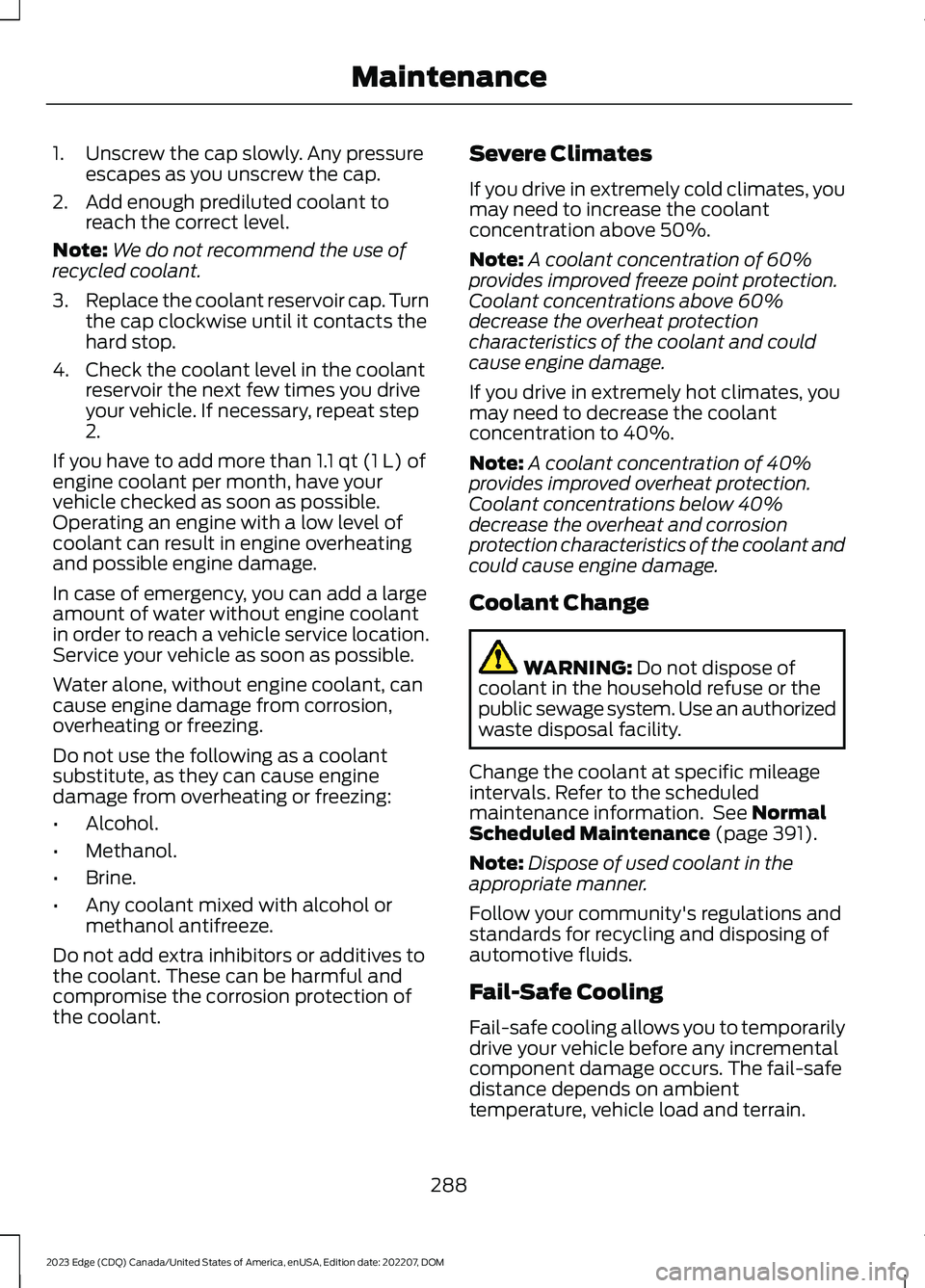
1.Unscrew the cap slowly. Any pressureescapes as you unscrew the cap.
2.Add enough prediluted coolant toreach the correct level.
Note:We do not recommend the use ofrecycled coolant.
3.Replace the coolant reservoir cap. Turnthe cap clockwise until it contacts thehard stop.
4.Check the coolant level in the coolantreservoir the next few times you driveyour vehicle. If necessary, repeat step2.
If you have to add more than 1.1 qt (1 L) ofengine coolant per month, have yourvehicle checked as soon as possible.Operating an engine with a low level ofcoolant can result in engine overheatingand possible engine damage.
In case of emergency, you can add a largeamount of water without engine coolantin order to reach a vehicle service location.Service your vehicle as soon as possible.
Water alone, without engine coolant, cancause engine damage from corrosion,overheating or freezing.
Do not use the following as a coolantsubstitute, as they can cause enginedamage from overheating or freezing:
•Alcohol.
•Methanol.
•Brine.
•Any coolant mixed with alcohol ormethanol antifreeze.
Do not add extra inhibitors or additives tothe coolant. These can be harmful andcompromise the corrosion protection ofthe coolant.
Severe Climates
If you drive in extremely cold climates, youmay need to increase the coolantconcentration above 50%.
Note:A coolant concentration of 60%provides improved freeze point protection.Coolant concentrations above 60%decrease the overheat protectioncharacteristics of the coolant and couldcause engine damage.
If you drive in extremely hot climates, youmay need to decrease the coolantconcentration to 40%.
Note:A coolant concentration of 40%provides improved overheat protection.Coolant concentrations below 40%decrease the overheat and corrosionprotection characteristics of the coolant andcould cause engine damage.
Coolant Change
WARNING: Do not dispose ofcoolant in the household refuse or thepublic sewage system. Use an authorizedwaste disposal facility.
Change the coolant at specific mileageintervals. Refer to the scheduledmaintenance information. See NormalScheduled Maintenance (page 391).
Note:Dispose of used coolant in theappropriate manner.
Follow your community's regulations andstandards for recycling and disposing ofautomotive fluids.
Fail-Safe Cooling
Fail-safe cooling allows you to temporarilydrive your vehicle before any incrementalcomponent damage occurs. The fail-safedistance depends on ambienttemperature, vehicle load and terrain.
288
2023 Edge (CDQ) Canada/United States of America, enUSA, Edition date: 202207, DOMMaintenance